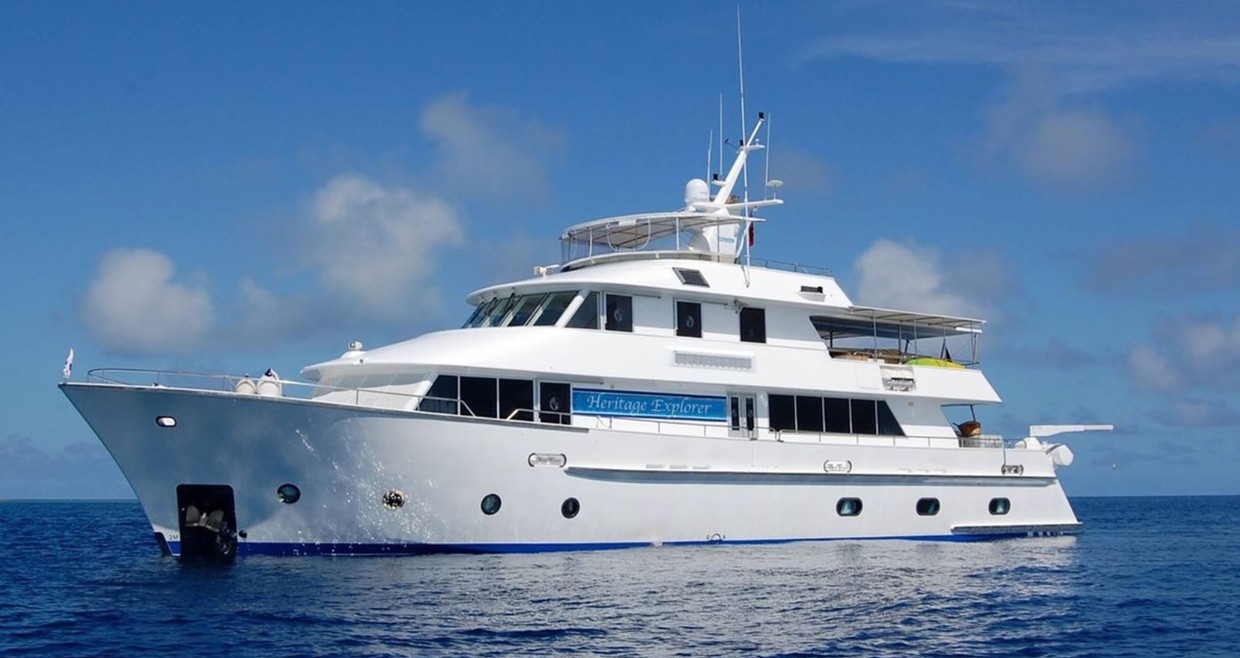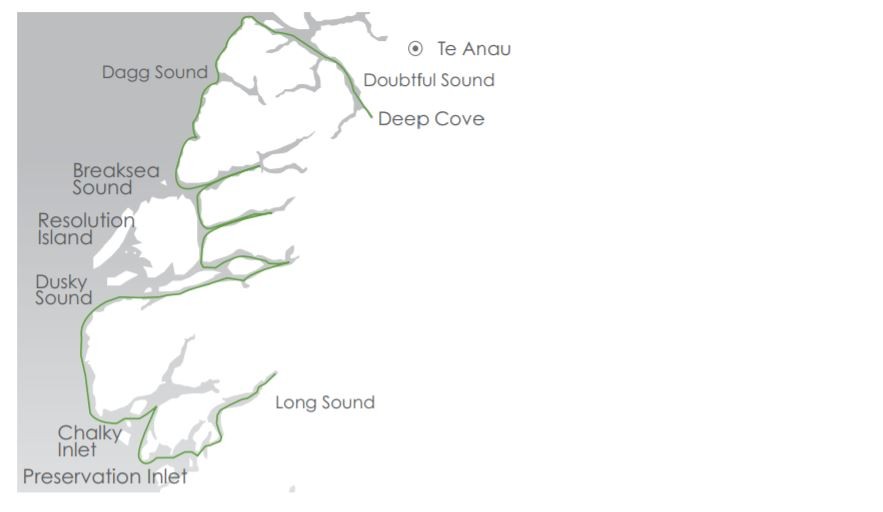from$ 5397 AUD
Note: Current p/p indicative rate. Final price may change due to currency fluctuations.
Heritage Explorer
Te Anau to Te Anau
Overview
Experience the grand scale scenery, untamed wilderness, ice-carved mountains, forests, sounds and unique wildlife of Fiordland’s Preservation and Chalky Inlets and Doubtful and Dusky Sounds on this 7-day exploration of the Southern Fiords. Rich in natural history, geology and the location of some significant historical firsts and important restoration and conservation projects, it is easy to see why this incredible region inspired our dream for responsible travel. Maori legend describes how demi-god Tu-te-raki-whanoa carved out the region’s fiords with his adze, Te Hamo, from rock walls to create the fiords we know today. Captain Cook and his crew were the first Europeans to visit, landing here aboard HMS Resolution in 1773 and subsequently spending five weeks in Dusky Sound. Cook’s records of his discovery and maps would attract sealers and whalers not long after, who would go on to form the first European settlements of New Zealand, historically this region is very important and shaped the future of the country. Fiordland’s Southern Fiords are only accessible by sea, making them some of the most remote areas of New Zealand’s mainland. Waterfalls, streams, rivers and fiords are enveloped with misty veils that come and go, revealing steep gradients of mountain peaks and sheltered valleys. A rugged terrain, the thickly forested floors are covered with ferns, lichens and mosses while the calm waters are home to Bottlenose Dolphins, Fiordland Crested Penguins and New Zealand Fur Seals. The isolation of the Southern Fiords has been beneficial in ensuring their epic beauty remains unspoiled and historic sites undisturbed. In these calm waters, away from the crowds, we plan to explore some of the most unique and wild parts of New Zealand as we sail though these beautiful fiords and landscapes.
Departures
Cruise Itinerary
Make your way to the designated meeting point in Te Anau then take in the awe-inspiring scenery as you enjoy a spectacular helicopter transfer to join Heritage Explorer in Preservation Inlet (times and meeting point will be confirmed with your voyage documents). The captain and expedition leader will be waiting to welcome you aboard Heritage Explorer and show you to your cabin. Settle into life aboard before we set sail along Long Sound and enjoy your first impressions of the fiords and the unrestrained landscape of Southern Fiordland.
Today is dedicated to exploring Preservation Inlet, rich in history we will delve into the gold mining and forestry attempts that once made this now quiet waterway a bustling hub of activity. The area’s natural bounty saw more than 2,500 gold miners and saw millers flock to the region in the late 1890s, this early settler history at mining towns Cromarty and Te Oneroa, now reclaimed by nature, can still be observed, none more spectacularly than at the failed Tarawera Mine and Smelter, where the ruins of the smelter’s three-storey chimney were restored in 2015. Among the activity Preservation Inlet can also lay claim to having New Zealand’s first whaling station at Cuttle Cove and the location of one of the country’s most remote lighthouses at Puysegur Point, which began operation in 1879 perched some 40-feet above the south island’s most southwestern point. Here a great coastal walk, formerly a telegraph track built to connect the lighthouse, leads to the old landing shed at Otago Retreat.
The entrance to Chalky Inlet is guarded by the impressive limestone cliffs of Chalky Island, the inspiration behind Captain Cook’s naming of the fiord. One of several important predator free islands in the inlet including Great Island and Passage Islands, Chalky Island is home to some of New Zealand’s most critically endangered bird species including the Little Spotted Kiwi and Kakapo, and endemic Te Kakahua Skink, discovered in 2002. The protected harbours at North and South Port offer much to explore as the centres of the human history in the inlet with North Port the final resting place of the rusting hulk of purposely grounded GSS Stella while South Port reveals an industrial past with the remnants of once prolific sawmilling activity. Sailing to the head of the fiord the surrounding mountains envelope us with their majesty.
Over the following two days we plan to leisurely expedition cruise through Dusky Sound visiting the some of the most significant historical and conservation sites in New Zealand as well as marvelling at the majestic scenery as we sail deep into the heart of Fiordland. A navigation through Acheron Passage, which separates Resolution Island from the mainland, is sure to be one of the highlights or our time in Fiordland. Predator-free Anchor Island homes half of the world’s population of Kakapo and Little Spotted Kiwi and is also the location of historic Luncheon Cove and a number of New Zealand firsts including New Zealand’s first sealing gang, the building of New Zealand’s first European homestead and first European designed ship, the 16-metre Providence built here and launched in 1795. On nearby on Pigeon Island learn the history of Richard Henry and his pioneering live transfer of birds to island refuges – an international first in wildlife conservation. While his attempts were unsuccessful due to stoats swimming over to the island, it is heartening to learn the island is now pest free and a sanctuary for native birdlife, with Henry’s vision fulfilled.
Flanked by towering cliffs and stretching inland for 13 picturesque kilometres, we hope to explore Dagg Sound before heading north to experience some of the most spectacular scenery in all of Fiordland – Doubtful Sound, or the sound of silence as it’s also known. Spanning some 40-kilometres and holding the title as New Zealand’s deepest fiord, Doubtful Sound with its cloud-scraping wilderness cloaked mountains, sheer stone cliffs, waterfalls, inlets, quiet coves and wildlife presents nature on the grandest scale. Photographic opportunities abound and our time spent here could include ship cruising Blanket Bay, the Shelter Islands, Pandora River, Deas Cove and Open Bay. Tonight we will find a sheltered anchorage in one of the many side arms that branch off the main fiord and enjoy a farewell dinner.
This morning we navigate to the very head of Doubtful Sound in Deep Cove home to several waterfalls including Helena and Lady Alice Falls. After a final breakfast and farewells, head ashore where a transfer to Te Anau, via the picturesque Wilmot Pass, the road constructed as part of the Manapouri hydro scheme, awaits. In case of unexpected delays, we ask you not to book any onward travel from Te Anau until after 3pm this afternoon.
Some voyages will operate the itinerary in reverse. During our voyage, circumstances may make it necessary or desirable to deviate from the proposed itinerary. This can include weather and opportunities for making unplanned excursions. Your Expedition Leader will keep you fully informed. Voyages are planned and scheduled pending final regulatory approval.
Heritage Explorer

Vessel Type: Expedition Yacht Length: 30 metres Passenger Capacity: 18 Built: 2004 New Zealand-built expedition yacht Heritage Explorer joins Heritage Expedition's small ship fleet creating new opportunities of discovery around the shores of New Zealand. Setting a new standard for discovery travel in New Zealand, Heritage Explorer combines the ultimate in comfort with unique itineraries and a personalised experience with a maximum of just 18 guests on board.Heritage Explorer is a 30-metre, 4-deck New Zealand flagged vessel built in 2004 by the renowned wooden boat building family Carey's Boatyard in Picton. It features a contemporary wood-finished interior, 10 well-appointed cabins across three decks, dining room boasting spectacular 180-degree panoramas and theatre capabilities; lounge and bar featuring a flight of inclusive regional New Zealand wines, beers and spirits; and a well-stocked local library. Outside, guests can enjoy plenty of covered space on the Bridge Deck, or ajourn to the Sun Deck perfect for wildlife spotting, sunrises and sunsets, or simply enjoying watch your voyage unfold. Kayaks and fishing equipment are available for use during the voyage, while two tenders allow for deeper exploration and the unforgettable wildlife encounters synonymous with all Heritage Expeditions adventures. As with as with our other vessels, Heritage Explorer will have an open bridge policy and a full commercial kitchen helmed by a talented chef focused on highlighting local produce and any guest catches of the day, as well as an enthusiastic and passionate expedition team, and will be shipped by a New Zealand captain and crew. The expedition yacht features state-of-the-art technology to provide a comfortable expedition with high performance dual Scania 653 horsepower engines, bow thrusters, fin stabilisers, full air-conditioning, sound attenuated twin generators and a hydraulic aft ramp, while a comprehensive navigation package ensures the ultimate Kiwi adventure awaits all guests. Accommodation Details Royal: Located on the Bridge Deck, our Master Suite features a spacious bedroom with a queen-sized bed, ample storage with wardrobe and drawers, mirror and washbasin, private en suite, personal climate control, TV, PABX satellite telephone, window and French doors opening out on to the covered Bridge Deck.Salvin's: Located on the Lower Deck, Salvin's cabins have the option of either a double bed or two lower berths. Both feature ample storage with wardrobe and drawers, TV, PABX satellite telephone, private en suite and a picture porthole. Wandering: Located on the Lower Deck, Wandering cabins feature one lower single berth, ample storage with wardrobe and drawers, TV, PABX satellite telephone, private en suite and a porthole. Buller's: Located on the Lower Deck, the Buller's cabin features one bunk (one upper and one lower berth), ample storage with wardrobe and drawers, TV, PABX satellite telephone, private en suite and a porthole.
Highlights
• Preservation Inlet • Chalky Inlet • Dusky Sound • Dagg & Doubtful Sounds
Map



